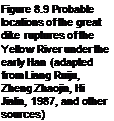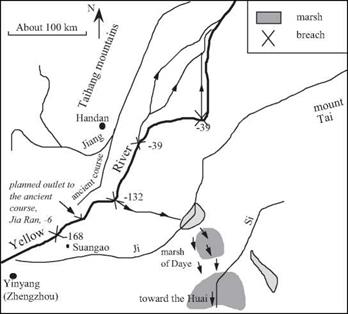The great Yellow River dike failures in the Han Empire
The Yellow River dikes are continually maintained and raised. In the 2nd century BC, they had already attained a height of some ten meters. The regions they protect along the lower course of the river had become among the most populated of all China, as we have seen earlier. A first dike rupture occurred in 168 BC at a place called Suangao to the northwest of Kaifeng, near the origin of the Ji River (Figure 8.9). This rupture destroys what was called at the time the “metal dike”, to the east of Suangao, but in the end the breach is repaired.[414]
Yet again in 132 BC the Yellow River broke through its dikes at Huzi and poured out onto vast agricultural regions to the south. When the flood levels dropped the river continued to occupy its new course, in the beds of the Si and the Huai rivers. The course change that had occurred five centuries earlier, in 602 BC, may have had limited impact, but it is not hard to imagine that the new change had rather dramatic consequences. Dike repairs were attempted, but without success as they failed once again. Finally the struggle was abandoned, perhaps under the influence of a counselor to the emperor whose lands were to the north of the breach, and therefore sheltered from the floods and perhaps increased in value due to the losses elsewhere.[415] [416] But the floods of the Yellow
River in its new course could no longer be controlled at all. In 120 BC, some 700,000
52
 |
 |
victims had to be relocated from this region toward Shaanxi.
A particularly dry year occurred in 109 AD, 23 years after the dike rupture. Emperor Wudi took advantage of the situation to bring a considerable armed force to the site, and succeeded in blocking the breach and restoring the river back into its original bed. The blockage was accomplished by throwing bundles of branches into the breach between clusters of bamboo stalks, and quickly covering them with rocks and earth. Sima Qian is, here, no longer a historian but an actual eye witness to the event. He is even an actor in the play, for he tells of having carried bundles of branches on his back, as did everyone in the emperor’s entourage. At the outset of his work, the Emperor Wudi threw a jade ring into the river and also sacrificed a horse. Sima Qian faithfully recorded a psalm that the emperor composed on this occasion:
“The river broke through at Huzi;
What could we do?
Beneath its rushing waves,
Villages all became rivers,
The villages have all became rivers And there is no safety for the land. (…)
The river raged from its boundaries,
It has left its constant course.
Dragons and water monsters leap forth,
Free to wander afar.
Let it return to the old channel And we will truly bless the gods. (…)
Ask the Lord of the River for me,
“Why are you so cruel?
Your surging inundations will not cease;
You grieve my people!
The city of Niesang is awash;
The Huai and Si brim over,
So long, and yet you will not return You overstep the watery bounds!” (…)
The Lord of the River hears our plea But there is not enough brushwood.
There is not enough brushwood – The fault of the people of Wey.
They have wasted the land with fire – What can be used to check the waters?
We sink the forest bamboo And ballast the weir with stones.
We will stem the break at Xuanfang
53
And bring ten thousand blessings!”-”
Eighty years later, in 39 BC, new dike ruptures occur further to the north, and the technique for closing them is further improved. Cages of bamboo filled with stones are [417]
brought to the site by boat and sunk from the edges of the breach, progressively reducing its width. Finally, boats are sunk at the site of the breach, and then the entire plug is covered with earth.[418]
There is no doubt that the situation on the lower course of the Yellow River continues to preoccupy the leaders. In 6 BC, an engineer called Jia Ran (or Chia Jang) submits a report to the emperor. He points out the potential danger of a poorly monitored dike, and calls attention to population and use of zones that should be kept open as flood plains, zones that represent a dangerous confinement of the main channel.
“At the present time, the nearer embankments stand at a distance of several hundred paces only from the water, and even the furthest are only several li from it. South of Liyang the old “Great Metal Dike” stretched north-westwards from the west bank of the Yellow River to the southern foot of the western mountains. It also ran eastwards to meet the eastern mountains. People built their cottages on the eastern side of the dike. After they have been living here a little over ten years, another dike was thrown out from the eastern mountains southward to connect with the Great Dike. Again, in the prefecture of Neihuang, a swamp with a circumference of several tens of li was drained by building a dike round it, and the governor of the district then gave the land within the dike to the people after they had lived here for more than ten years. Now people build cottages in it. These things I have myself seen. In the prefectures of Tungchun (Eastern Commandery) and Paima, the old “Great Embankment” is paralleled by several other embankments (outside it), and people live in between them. From the north of Liyang to the border of (the former state of) Wei, the old “Great Embankment” lies several tens of li from the river; but inside it there are also several rows of dykes which were built in earlier generations.”
These dikes, built without any planning, provoke the Yellow River into useless and dangerous changes of direction:
“Thus when the Yellow River flows from Honei north to Leiyang there is a stone embankment forcing it eastwards. When it reaches Tungchun and Phingkang, there is another stone embankment to force it north-west. When it arrives at Leiyang and Kuanhsia it meets a third, changing its flow north-eastwards again. At Tungchun and Chinpei it is diverted north-west, and at Weichun and Chaoyang north-east again – all by stone embankments. Thus in a distance of only a little over a hundred li, it is turned westward twice and eastward three times…”[419]
Jia Ran has Taoist instincts. He proposes that the Yellow River be left to occupy its natural flood plains, free of habitations and obstacles. He specifically proposes that the populations in these zones be moved out, and that a natural outlet and floodplain toward the river’s ancient bed be opened further to the north (Figure 8.9). In the event that the emperor does not have the will to relocate the population, Jia Ran proposes an alternative. This would be that a dense irrigation canal network be built with solid stone protection, making it possible to irrigate the region during normal periods and to handle the floodwaters in wet periods, thus reducing their threat to the principle course of the river.
A third proposed solution, consisting simply of raising the existing dikes, is clearly nothing more than a token one. But the Emperor Aidi is young, the empire no longer having the strength it had under Wudi, and so the energetic measures proposed by Jia Ran are not adopted. This makes catastrophe inevitable.
The catastrophe occurred in 11 AD. The river comes out of its bed never to return, punctuating a three-year period of usurpation of power by a dignitary called Wang Mang who attempts political reform. The new course of the river, destined to be stable for nearly eight centuries, is some fifty kilometers further to the east (Figure 8.2) than the course into which the Wudi had redirected it. The event itself was devastating as can be imagined. And then regional famine ensued, since the crops were destroyed. In subsequent years floods return over and over again, since the river was no longer in its diked bed. The population flees and there are revolts, subversively led by the secret society of the Red Eyebrows. All of these troubles likely contribute to the eviction of Wang Mang in 25 AD and the return to power of the Han family (these will become the “latter Han”).






Leave a reply